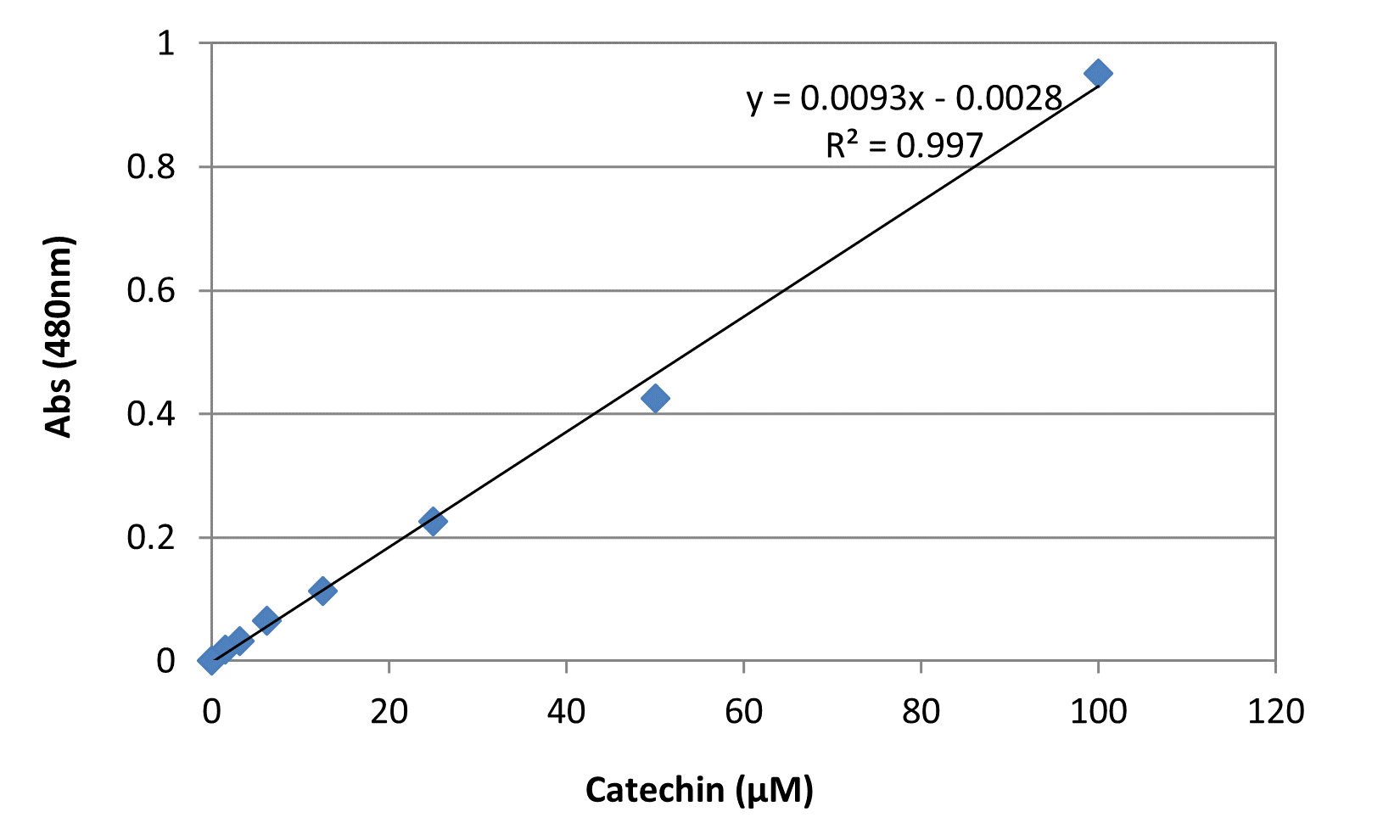Amplite® Colorimetric Phenolic Compounds Assay Kit
Product key features
Amplite® Colorimetric Phenolic Compounds Assay Kit enables accurate quantification of total phenolic content in complex sample matrices.
- High Sensitivity: Detects phenolic content with a limit of 0.02 mM catechin equivalents (CEs)
- Enhanced Specificity: Minimizes interference from non-phenolic reducing agents, ensuring accurate measurements
- Broad Applicability: Compatible with complex matrices such as plant extracts, foods, and beverage
- Comparable alternative: Offers a reliable solution similar to the Folin-Ciocalteu-based phenol quantification kits
Product description
The Amplite® Colorimetric Phenolic Compounds Assay Kit is a highly sensitive and specific assay for quantifying total phenolic content in diverse biological samples. The assay is based on the reaction between phenolic compounds and diazonium salts under alkaline conditions, forming a stable diazo chromophore that can be quantified by absorbance at 480 nm. Unlike the Folin-Ciocalteu method, this assay minimizes interference from non-phenolic reducing agents such as sulfites, reducing sugars, and ascorbic acid, ensuring greater specificity for phenolic compounds. With a detection limit of 0.02 mM catechin equivalents (CEs), the assay is compatible with high-throughput workflows and is validated for applications involving complex matrices such as fruits, vegetables, beverages (e.g., tea, wine, coffee), processed food products, plant extracts, and herbal or nutraceutical formulations.
Phenolic compounds are a diverse group of phytochemicals widely distributed in dietary and medicinal plants, including fruits, vegetables, cereals, and beverages such as tea, coffee, and wine. These compounds, encompassing phenolic acids, flavonoids, stilbenoids, lignans, and polyphenols, play essential roles in plants, such as UV protection, herbivore deterrence, and developmental signaling. In humans, their potent antioxidant properties have been linked to reduced risks of cardiovascular diseases, cancer, and neurodegenerative disorders. Additionally, their antimicrobial, anti-inflammatory, and immunomodulatory effects underscore their significance in both biomedical research and dietary science.
Example protocol
AT A GLANCE
Prepare and add standards and samples (100 µL).
Add 20 µL Phenolic Compound Probe to the wells of standards and samples.
Add 80 µL Phenolic Compound Assay Buffer to the wells of standards and samples.
Incubate the reaction at room temperature for 5 to 30 minutes.
Monitor the absorbance with an absorbance plate reader at 480 nm.
Note: Bring kit components to room temperature before starting the experiment.
PREPARATION OF STANDARD SOLUTIONS
https://www.aatbio.com/tools/serial-dilution/11332
SAMPLE EXPERIMENTAL PROTOCOL
STD1 | STD1 | TS | TS | ||||
STD2 | STD2 | ||||||
STD3 | STD3 | ||||||
STD4 | STD4 | ||||||
STD5 | STD5 | ||||||
STD6 | STD6 | ||||||
STD7 | STD7 | ||||||
BL | BL |
Table: 1 Layout of Catechin standards and test samples in a clear bottom 96- wells microplate. Catechin standards (STD7-STD1: 100 µM to 1.55 µM), TS= Test Samples, BL = 0 µM Catechin.
The following protocol can be used as a guideline and should be optimized accordingly.
Prepare the standards and test samples according to the recommended protocol, and add 100 µL of each into the wells of a microplate.
Add 20 µL Phenolic Compound Probe (Component A) to each well containing standards and samples.
Add 80 µL Phenolic Compound Assay Buffer (Component B) to the wells of standards and samples.
Incubate the reaction at room temperature for 5 to 30 minutes.
Monitor the absorbance with an absorbance plate reader at 480 nm.
References
Authors: Verrillo, Mariavittoria and Cozzolino, Vincenza and Spaccini, Riccardo
Journal: Methods in molecular biology (Clifton, N.J.) (2025): 223-227
Authors: Wang, Miao and Sun, He-Nan and Liu, Xing-Yu and Liu, Mingjun and Li, Shan-Shan
Journal: Bioelectrochemistry (Amsterdam, Netherlands) (2025): 108838
Authors: Wang, Jikai and Xie, Zhulan and Xie, Haitao and Mo, Ziyi and Wang, Weiguo and Zhu, Yanli
Journal: Biosensors & bioelectronics (2025): 116857
Authors: Ye, Chenqian and Wang, Axue and Lu, Yuxin and Lin, Xinye and Huang, Luqiang and Li, Daliang
Journal: Sensors (Basel, Switzerland) (2024)
Authors: Cao, Jiaying and Wang, Zhiguo and Jiang, Yuning and Zhou, Huimin and Liang, Qiuju and Guo, Xiaoyu and Wen, Ying and Yang, Haifeng
Journal: Talanta (2024): 126681

